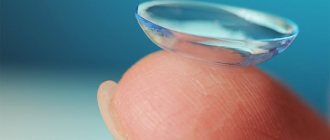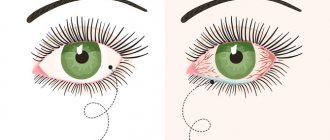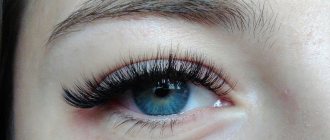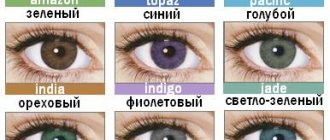Neglecting the rules of wearing and caring for lenses can lead to a number of unpleasant consequences, since against the background of prolonged contact of the product material and the cornea, oxygen starvation occurs and the functioning of blood vessels is disrupted. This provokes the development of red eye syndrome, irritation and inflammation of the mucous membrane. In addition, the chances of developing conjunctivitis, keratitis and even glaucoma increase. Due to insufficient tissue hydration, the chances of infectious diseases that require long-term and complex treatment increase. In this article we will talk about what to do if your eyes turn red from contact lenses.
Symptoms
Wearing lenses is a popular method of vision correction. When using this correction product, you must follow the rules of wearing and care to avoid the development of unpleasant complications. There are several symptoms to watch out for:
- irritation and redness of the eye;
- the appearance of foci of inflammation;
- dryness or increased watery eyes;
- sensation of a foreign object;
- fog or spots before the eyes;
- pain when contacting the lens and cornea;
- photophobia.
If at least one of these signs bothers you for a long time, you should switch to glasses as soon as possible and make an appointment with an ophthalmologist. How to treat redness under the eyes, in children and adults, read here.
If your eyes turn red with new lenses, you should wait a while. This may be a normal reaction to the corrective product and goes away within 1-2 days.
Causes of eye redness after long-term wear of lenses
A typical complication after wearing lenses of any type is red eye syndrome. This pathology is associated with impaired blood supply and oxygen metabolism of corneal tissue. Leads to severe redness, dryness, discomfort and pain. This can be caused by a number of reasons, such as illness, infection, injury or normal misuse. Find out how to choose the right toric lenses here.
Allergies, if your eyes turn red and hurt - how to treat them
Eye pain occurs with increased sensitivity to the material, composition of the solution for storage and care. Allergies most often begin with an acute form, accompanied by irritation, itching and severe redness of the mucous membrane and eyelids. To check for a pathological reaction, it is enough to replace the care solution or optical medium. Symptoms are quickly relieved with antihistamines.
Damage to membranes, foreign object
When a foreign object gets between the lens and the cornea, mechanical irritation of the eye tissue occurs. The result is severe redness and irritation, and increased tear production. To prevent this problem, before installation it is recommended to use drops for moisturizing and correctly follow the rules of care for the corrective agent (rinse, use an airtight container and solution). Find out about the cause of redness in the whites of the eyes in this article.
Time not met
Each model has an optimal wearing period - it varies from 24 hours to 90 days. Then the structure of the material changes, increasing the chances of redness, irritation and injury to the cornea. When using an old lens, the cells do not receive enough oxygen, which is one of the causes of “dry eye” syndrome. In order to comply with the rules of wearing contact lenses, and also not to miss the necessary time for replacing the corrective agent, it is recommended to record the time of opening the package and the start of use in a diary. Read about drops for dry eyes at this link.
Even during the purchase, you should pay attention to the integrity of the blister. Violation of tightness makes it impossible to use this correction tool.
Poor hygiene
Redness of the eyes is often caused by a common violation of care and storage requirements. After each removal, they must be washed and placed in a plastic container with a screw-on lid. This avoids infection, dirt and small particles from getting on the surface of the cornea. Neglect of hygiene provokes the development of inflammatory diseases, leading to persistent redness and irritation of the eyes. This material will tell you why lenses are dangerous for restoring vision.
Infection
Pathogenic bacteria, viruses and fungi that get on a contact lens pose a huge danger to eye health. The only method of prevention is to follow the rules of care and wearing correction products. If you experience any discomfort, redness or suppuration, you should consult a doctor as soon as possible. The choice of treatment depends on the pathogen and symptoms.
Infectious diseases develop quickly, are difficult to treat and cause complications.
Injury
A common cause of red eye syndrome is the contact of a foreign object with the surface of the corneal tissue during wear or installation. An ordinary speck of dust, a piece of sand or dirt can cause severe irritation, redness and pain. If discomfort occurs, you should remove the lens, drip a moisturizer, and blink vigorously several times. If symptoms persist or worsen, you should make an appointment with an ophthalmologist.
Hypoxia
This is insufficient oxygenation of the eye tissues. Occurs with constant wear, especially models with a long period of use. Hypoxia leads to severe redness and dryness of the cornea. To avoid this problem, you should follow simple hygiene rules and be sure to remove the correction product at night. This stimulates the natural processes of moisturizing and cleansing the surface of the eyes with tear fluid. For prevention, it is recommended to purchase one with a high oxygen permeability rate, and also use drops.
When choosing, it is important to carefully check the basic physical indicators, diameter and wearing period. This allows you to adjust the correction regimen and reduce the risk of complications.
Why eyes turn red from lenses: causes, symptoms -
Contact lenses replaced glasses and almost immediately gained popularity among people with vision problems.
Every year, manufacturers improve this optical device, making it safe and comfortable to use. However, violation of the rules of “operation” and disinfection leads to negative consequences. Those who wear them on a regular basis are faced with the problem of red eyes when wearing contact lenses.
Symptoms are not a sign of any abnormality, but require immediate consultation with an ophthalmologist.
Brief information about red eye syndrome
What is the reason for the popularity of contact lenses? In them, a person feels more comfortable than glasses and can lead a normal lifestyle, without any restrictions.
The optical device allows you to play sports, does not reduce the field of view, and does not put pressure on the nose and ears. However, the slightest neglect of wearing norms will lead to serious complications and health problems. Red eyes after contact lenses are one of the consequences encountered when recommendations for their use are not followed.
Often, such symptoms signal the development of pathologies such as conjunctivitis, glaucoma, etc. Any deviation from the norm associated with the ocular apparatus requires immediate treatment.
When wearing contact lenses, the eyes often experience oxygen starvation and problems with the normal functioning of the tear film. In this way, favorable conditions are created for the proliferation of pathogenic microorganisms that provoke the development of infectious diseases. The most serious pathology faced by lens wearers is inflammation of the cornea.
| Ophthalmologists do not recommend using vision correction devices on an ongoing basis. It should be worn only when absolutely necessary, with the exception of those lenses that are made of high-quality and “breathable” material. At the first opportunity, take them off and give your eyes a rest. |
Why can my eyes turn red after contact lenses?
People who do not want to part with a convenient optical device even at night often experience a symptom such as red eyes. The following factors can provoke the appearance of such a sign:
- Constant violation of the rules of "exploitation". Remember that the maximum period of stay in them is from eight to fourteen hours;
- The body's reaction to accumulated deposits. To clean lenses, use hydrogen peroxide;
- Intolerance to the components included in the optical instrument storage solution. Choose a liquid that does not contain substances that cause you allergies;
- Damage to the cornea due to non-compliance with wearing rules. In addition to red eyes, symptoms include increased tearing, fear of bright lights, and discomfort. In this case, immediately remove the lenses and immediately seek help from an ophthalmologist.
According to doctors, the most common cause of red eyes is an inappropriate solution. It just needs to be changed, there are a lot of options on the market, so this won’t be a problem.
Buy several types and, through observation, select the optimal composition. Why do my eyes turn red from contact lenses? Only an ophthalmologist after an examination will give an exact answer to this question.
He will select the right therapy, so in this case you should not self-medicate.
What to do to eliminate the symptom?
If it is not possible to immediately visit a medical facility, a few simple tips will help that will relieve unpleasant symptoms:
- Make sure that your home medicine cabinet always contains eye drops to cleanse the visual organ of harmful substances and contaminants;
- Wash your face several times throughout the day. This will not get rid of redness, but will enhance the effect of the droplets;
- Change the solution;
- Don’t forget about sunglasses, they will “save” you from harmful ultraviolet radiation and prevent dust and debris from entering your eyes.
| As soon as the opportunity arises, immediately go to an ophthalmologist! |
Recommendations for choosing lenses and their use
There are several unshakable canons that should be followed when purchasing an optical device.
On store shelves you can find a unique invention - “breathable” lenses that provide full access of oxygen to the eyes in the required quantity. You can stay in them for a long time. The visual correction device is worn for a maximum of thirty days without removal. But they cannot be used longer than the specified period.
If you have been wearing lenses for a long time, and redness has recently appeared, the most likely reason is their wear. From constant “exploitation” they lose their elasticity and cause irritation. Therefore, it is important to follow the recommendations of specialists on the correct use of optical devices:
- Only an ophthalmologist should select contact lenses;
- Use a special container for storage;
- Wash your hands thoroughly with soap and water before putting them on or taking them off;
- You can wear the vision correction device for a maximum of fourteen hours;
- Each time the lens must be stored in fresh solution. Do not use one portion several times;
- If you get sick or have an allergic reaction, stop using them temporarily;
- People who wear this optical device constantly need to purchase specialized cosmetics.
| Following simple recommendations will help you avoid many negative consequences. |
Conclusion
Contact lenses require special attention and care. If you decide to “get” such an “accessory,” then learn the rules for wearing and storing them.
Remember that vision is a gift from nature. Eye health is associated with the use of contact optical devices.
Even a minor impairment can reduce visual acuity, so do not neglect the rules for the “use” of lenses.
You will find out what harm a vision correction device can cause by watching the video.
Why do my eyes turn red from contact lenses? Link to main publication
Source: https://zdorovoeoko.ru/korrektsiya-zreniya/kontaktnye-linzy/pochemu-krasneyut-glaza-ot-linz/
What to do to eliminate the symptom
There are several methods to treat and prevent red eye syndrome. The use of pharmaceutical drugs is considered especially effective; simple home methods are also allowed for prevention. If you wear lenses and your eyes become red, you should consult your doctor to choose the most comfortable correction method.
Medicines - what you can put in your eyes
These are various drops for red eyes, and solutions for the care and treatment of diseases, maintaining hygiene while wearing. The specific remedy should be selected by an ophthalmologist depending on the condition of the cornea and symptoms.
Before instilling the drug, be sure to remove the lens and blink several times. Cost – 398 rub.
Visine
These are vasoconstrictor drops, the active ingredient is tetrizoline. Visine is recommended to relieve swelling and redness of the conjunctiva, which are caused by allergies, mechanical or chemical factors. Apply only 1 drop per eye 2-3 times a day. The drug can be addictive, the course should not exceed 10 days. There are contraindications - age under 2 years, angle-closure glaucoma and hypersensitivity to the components.
Taufon
Drops are suitable for the active treatment and prevention of many eye diseases. They contain taurine, an amino acid that enhances the restoration of metabolic processes and normalizes the functions of cell membranes, which is important for preventing corneal dystrophy. Taufon is suitable for regular eye care and rarely causes complications. Recommended dosage is 1-2 drops 2 times a day.
Emoxipin
Eye drops, when wearing lenses, are prescribed to protect the blood vessels of the visual organs and improve microcirculation. After use, they increase the retina’s resistance to external influences and promote the resorption of local hemorrhages. Emoxipine rarely causes side effects; in fact, it has contraindications. The duration of treatment is up to 30 days at the rate of 1-2 drops up to 3 times a day.
Emoxipine is prescribed if red blood vessels are observed from prolonged wearing of correction products. The substance does not react with the storage and care solution.
Traditional methods for treating redness at home
In addition to traditional drugs, traditional methods are used to treat red eye syndrome. They have poor effectiveness and are not suitable for hypersensitivity. You should follow the recipe and refuse further use of the method if the slightest discomfort occurs.
Chamomile decoction if your eyes are red after wearing contact lenses
The product has an anti-inflammatory and healing effect. To prepare chamomile, pour 1 tbsp. l. dried flowers 200 ml hot water. Let sit for 15 minutes and then rinse eyes. If symptoms are severe, repeat the procedure at least 2 times a day.
The procedure for instilling chamomile infusion is done daily for 2-3 months. If redness appears in the eye, stop the insufflation procedures until it disappears, then continue until the end of the course of treatment.
Lotions made from cucumber, apples, potatoes
The recipe helps eliminate redness and relieve swelling of nearby tissues. To prepare the lotion, take half an apple, a cucumber and a raw potato and grind until puree. Wrap the mixture in gauze and apply to the eyelid area for 15-20 minutes.
Cold compress
This method is suitable for relieving acute symptoms when there are no pharmaceutical drugs nearby. As a compress, it is recommended to use a decoction of chamomile or oak bark, or a bag of regular tea. Apply the pre-prepared and cooled mass to the closed eyelid and hold for up to 15 minutes.
Infection due to poor hygiene
All lenses, except daily ones, require careful regular care, especially quarterly and traditional ones. During operation, they accumulate a lot of contaminants: protein and lipid deposits from tear fluid, dust particles, and cosmetics. Together they form plaque, which is a favorable environment for the proliferation of pathogenic microorganisms. To remove this deposit and clean the surface of the optics, special products are used:
- universal solutions for every day;
- enzymatic (enzyme) cleaners, which should be used to clean protein deposits once every 10 days;
- peroxide deep cleaning systems - once a month.
If the recommended hygiene rules are not followed, the accumulated contaminants will cause itching and irritation in the eyes, and, in addition, will provoke the development of infectious inflammatory diseases: keratitis, conjunctivitis, etc. If you violate the wearing regime and leave daytime wear models on your eyes at night, or use them without removing them for several days, similar reactions occur.
Red blood vessels after wearing lenses
Pronounced red blood vessels in the eyes are a typical sign of impaired blood supply and oxygen metabolism when worn regularly. Occurs against the background of the following problems:
- allergy;
- trauma or mechanical impact on the cornea;
- conjunctivitis;
- keratitis;
- corneal dystrophy.
If you removed the lens and discovered that your eye is now red, you should contact a specialist as soon as possible. This may be a sign of a serious illness or infection that requires immediate treatment.
Dry eye syndrome
Dry eye syndrome, or xerophthalmia, affects many people. In recent years, this disease has especially developed due to the frequent use of gadgets and computers, with which other users spend a lot of time. In this case, severe drying of the mucous membrane occurs. Normally, a person blinks approximately 11-12 times per minute. When looking intensely at the monitor, the blinking frequency decreases by about half to 5-6 times. At the same time, the tear film dries out, the eye tends to be moistened from the inside, and a rush of blood occurs to the vessels of the conjunctiva. The organs of vision turn red, a feeling of dryness and irritation appears. At the same time, the lens can also dry out at the end of the day, as it lacks natural hydration from tear fluid. Ophthalmologists recommend that people who spend a lot of time at the computer use moisturizing eye drops. They often contain hyaluronic acid. It has the ability to bind together and hold water molecules on the surface. Products with sodium hyaluronate form a thin film on the surface of the lenses, thereby preventing their dehydration and providing long-term hydration.
The lens is turned inside out and is not worn correctly
If your contact lenses are placed incorrectly on your eyes, you may also experience eye discomfort. Before putting them on, make sure that the lens is not turned backwards. It should look like a smooth hemisphere, and not a flat bowl with bent edges. Some models (for example, ACUVUE) have special indicator marks that help you ensure that the lens is in the correct position. For convenience, you can also use a suction stick, which makes putting it on easier, especially for those new to wearing optics.
Selection of suitable lenses with a doctor
If contact lenses are a vital necessity, then to ensure eye health and prevent redness during their use, it is necessary to choose the right optics.
Only a specialist can select high-quality lenses and determine their diopters correctly. It must be remembered that thoughtless purchases without an ophthalmologist's prescription can negatively affect the quality of vision.
Experts have several basic criteria that you should rely on when purchasing optical lenses. Today, manufacturers offer many new products, including breathable material that can be worn without interruption for about 30 days. You must strictly follow the rules of wearing and do not use lenses for more than the prescribed time. Otherwise, the material becomes thinner and loses elasticity. The result of all this is redness, which is irritation of the mucous membrane.
To avoid problems associated with wearing contact lenses, you should pay special attention to the selection and daily care of optical accessories. Following simple rules will not only help maintain the quality of visual function, but will also extend the life of contact lenses.










